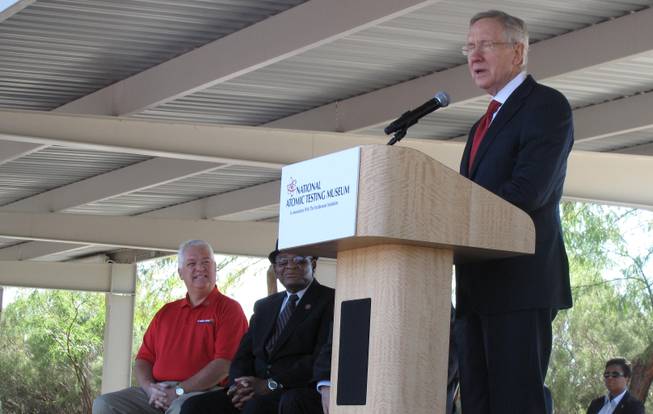
U.S. Sen. Harry Reid, right, speaks at the dedication ceremony of the National Atomic Testing Museum on Friday, Oct. 26. Watching on are Kevin Fitzgerald of the Cold War Patriots, left, and Bishop Sylvester Hooks.
Friday, Oct. 26, 2012 | 3:47 p.m.
Reid involved in accident
For decades, Nevada served as the epicenter for the nation’s nuclear arms testing program, hosting more than 1,000 nuclear detonations since 1951 at the test site north of Las Vegas.
The state also serves as the central repository for all the information and artifacts related to the country’s nuclear testing program after the Atomic Testing Museum on the UNLV campus was designated a national museum at the end of 2011.
On Friday, the museum celebrated its new status with a dedication ceremony featuring Senate Majority Leader Harry Reid and other federal officials. They also took time to honor former nuclear weapons workers in advance of the Oct. 30 National Day of Remembrance.
“All of the sacrifices made at the test site led to us winning the Cold War. … How could we not have a museum to designate what happened up there?” Reid said. “What went on up there was as important as virtually anything we’ve ever done to preserve liberty for our great nation.”
Reid recounted memories from his childhood watching the bright flashes in the sky and feeling the occasional rumbling from bombs being detonated at the Nevada Test Site more than 100 miles away from his home in Searchlight.
“It’s hard to comprehend that we did that,” Reid said of the above-ground tests, which were halted in 1962.
The national museum designation was awarded on Dec. 31, 2011, when President Barack Obama signed the National Defense Authorization Act into law. The National Atomic Testing Museum is the 37th museum to receive the designation and only the 18th outside of Washington, D.C.
The recognition came seven years after the private, nonprofit museum opened. Inside, visitors are taken through the history of the Nevada Test Site and the development of the country’s nuclear program, with artifacts like Geiger counters, replica bombs and other memorabilia help bring the Atomic Age to life. Exhibits deal with topics including atmospheric testing, underground testing, environmental impacts of nuclear detonations and challenges with disposing nuclear material.
Allan Palmer, executive director of the museum, said becoming a national museum comes with added responsibilities to expand the scope of the exhibits to tell “the national story of nuclear weapons testing.”
“We’re going to get a whole lot bigger in a hurry,” Palmer said, adding the museum might have to leave its current spot on the UNLV campus in the coming years due to a lack of space.
“The reason they started (the museum) was to capture the story of the test site, so it wouldn’t disappear,” Palmer said. “It was made a national museum to forever capture the story of the people who sacrificed and made (the nuclear program) possible.”

Join the Discussion:
Check this out for a full explanation of our conversion to the LiveFyre commenting system and instructions on how to sign up for an account.
Full comments policy